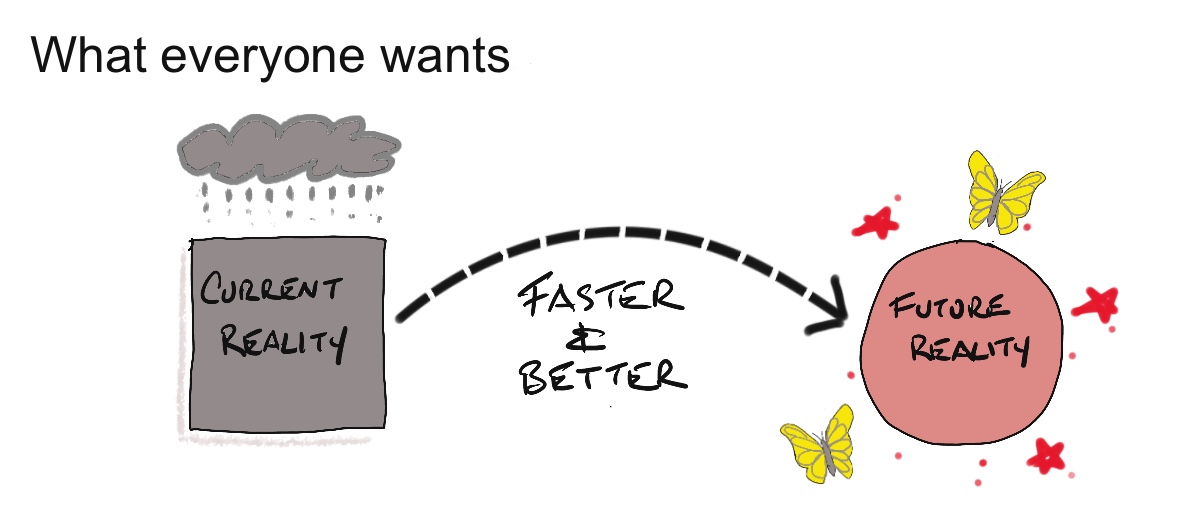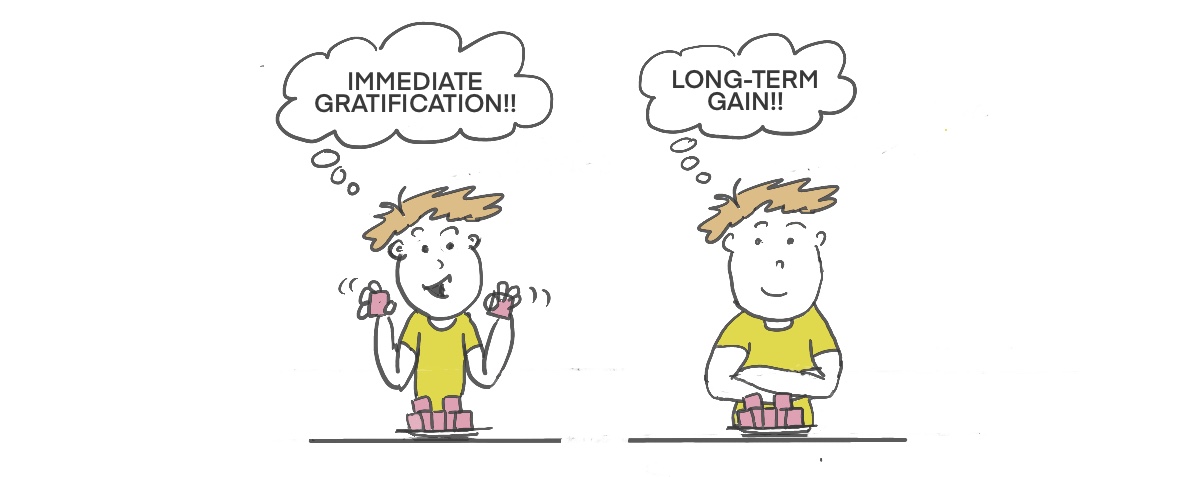A Better Way to Win More Sales
Soon after arriving for my meeting, my client opened with “Tell me about your program.” I’d been anticipating this meeting for over a month and couldn’t wait to talk about my time management training. Within minutes I was deep into the details - all the lessons and learning methods I had developed over the last decade. All great stuff.
But, not what the client needed to hear and I didn’t get the work. For many years I believed my contracts were won or lost based on their fit for my client’s needs. While you do need to have the right solution at the right time, there’s one more critical factor - the order you present your solution.
Order is everything

Here’s the secret to selling anything:Everyone wants to know how to get from where they are (current reality) to where they want to go (future reality) faster and better than they can on their own. This is true for someone trying to lose weight, save money, or learn how to play the guitar.
But, before you can help anyone get to their desired future reality they need to trust that you truly understand their problem and struggles. I see many consultants, corporate trainers, and keynote speakers making this mistake far too often. They start with the solution, not the problem. When you start with your solution it’s like serving dessert before dinner or putting your shoes on before your socks.
Order is everything.
If you want to sell more you need to first put your presentation in order. There are 5 steps to a successful sales pitch.
1. Problem

“I’m curious,” I started “what made you reach out to me for this meeting?”
“Hmm, great question.” my client responded, pausing to reflect.“
“Of course, we can always use a brush-up on time management skills,” she added, “But, I feel we need some kind of digital detox. The increased time on screens is distracting and, for some of our team, it’s creating real stress.”
All solutions start with a problem.
Before you can deliver a solution you need to truly understand the problem. In this case, I could have blindly pitched lessons on effective use of email, digital meetings, or even less obvious problems like sitting too much. By asking one simple question (why did you want this meeting?) I uncovered a completely different problem begging for a solution.
Once you understand the problem and confirmed that you do, you are ready to suggest a solution. Skip this step and you’re effectively saying to the client they are no different from anyone else. This is when to use the ‘ask, tell, ask’ model to ensure you’re getting to their real needs and they feel heard.
Start by asking what is the problem.
Then tell them, in your words, what you think you heard and understood.
Finally, ask if that is correct.One tip is to take notes.
It’s a small detail, but when you take notes you signal that what you are hearing is important.
2. History
“Before I present my program,” I suggested, “I’m wondering what you’ve already tried to help your team get off their phones and screens?”
“Well, I did circulate some articles I found online.” my client replied, “And we’ve started to turn our phones off in meetings - even online meetings.”
I’ve never met a client who hasn’t tried to fix their problem. Your job is to dig into that history and uncover a gap in their approach.It could be they didn’t first survey their team or failed to get buy-in to a program, or maybe they simply had the wrong approach. Taking time to learn their history goes a long way to building a future of trust and empathy and opening their mind to new approaches.Tip: This is the time to practice your active listening skills, including “double-clicking” on their responses with “That’s interesting, tell me more.”
Now, that you know what the problem is and what they have tried, it’s time to learn about their future reality.
3. Prospection

“If we were to go ahead with a training program,” I ask “what would an ideal solution look like?”
“Quite frankly,” my client replied, “I’d be happy if everyone took away even one thing they could practice daily.”
“Even better,” she added, “would be we have some kind of new agreement on how we will support each other as a team.”
At this point, you might be chomping at the bit to pull out your PowerPoint for the pitch. Hold your horses—you have one more critical bit of psychology to employ first. It’s called prospection. When we take a moment to imagine (prospection) a future vacation, a new vehicle, or even a happier work team we’re more likely to invest in making that future a reality (think, the infamous Marshmallow experiment by Walter Mishel).
Remember, every client wants to get from where they are to where they want to be, faster and better. Instead of launching into what you can do, ask them what an ideal solution looks like. Tip: use open-ended questions, like “What would make this program a complete success for you?” or “What would you like team members to say about this event?”
4. Solution
Finally! You’ve patiently explored the needs of your client, the remedies they’ve tried, and what their ideal future looks like. Now it’s time for your solution. A word of caution: this is not the time for a 36-slide PowerPoint deck, awkward acronym that spells “LEADERSHIP”, or 12-point teamwork solution. Simple sells.
I often remind my coaching clients that who ever they are presenting to probably needs to turn around and pitch someone else. For example, if I was meeting with the VP of HR, they might have to sell the CEO on my solutions. So, keep it simple.
Instead of presenting some complicated, multi-page solution, boil everything down to a one-page progression from start to end. And instead of text-heavy, work a little harder to use simple diagrams that illustrate your progression. Tip: always match a “deliverable” (what you are being paid to do) with an outcome (change in expected behaviour).
5. Next steps
Congratulations, you’ve made it to the next steps. And now for that (nervous) moment when you need to ask for the sale. Actually, you don’t.
If you’ve done your job right by asking the right questions, confirming what you heard, and keeping your solutions simple and actionable, the next step will be obvious. So, instead of asking for the sale, assume that has happened and ask questions about getting started. It could sound something like this:
“If we were to get started, would next month work?” and “Before we could get started, who else on your team would you need to speak with?” and “Would you like to enroll your whole team in this initiative, or start with a pilot program?”
Just like eating the proverbial elephant, help your client make one small decision at a time.
One more thing
My father once said the “best time to buy a house is when you don’t need it.” In other words, when you are happy with the deal, but also happy to walk away you typically sell and negotiate better.
That lesson has served me for over four decades.
Before a big sales presentation, I always remind myself that this could be great (income) or it could be not-so-great (challenging client, difficult logistics, low margin, etc.).
If you are good at what you do and know you can help your client, your final step before presenting your solutions is to know you can always walk away.
More articles on sales, mindset and small wins:
Hyperbolic discounting and why your goals suck
How to get started on your goals with small wins
Small Wins - why little steps are the path to big rewards
Small Wins - Why Little Steps are the Path to Big Rewards
Keynotes and workshops by Hugh Culver

